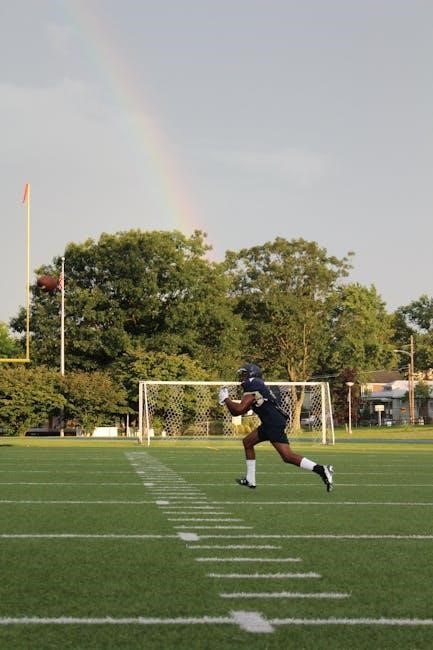The Wishbone Offense is a run-heavy, ball-control system emphasizing physicality and misdirection. Popularized in the 1970s and 1980s, it remains a powerful, efficient strategy.
1.1. Historical Background of the Wishbone Offense
The Wishbone Offense emerged in the early 1970s, popularized by coaches like Darrell Royal and Barry Switzer. It evolved from the Wing-T and Option-based systems, emphasizing a triple-option attack. The formation’s name comes from its resemblance to a wishbone, with three backs aligned behind the quarterback. Known for its physical, run-heavy approach, it dominated college football in the 1970s and 1980s, particularly at programs like Oklahoma and Texas. The Wishbone’s success relied on precision, discipline, and the ability to control the clock, making it a cornerstone of option football history.
1.2. Key Characteristics of the Wishbone Offense
The Wishbone Offense is characterized by its unique formation, featuring three running backs and a tight end. It emphasizes physicality, misdirection, and ball control; The triple-option attack allows the quarterback to read defenses and distribute the ball effectively. Play action passing is minimal, focusing instead on establishing a powerful rushing game. Discipline and timing are crucial, as each player must execute their assignment precisely. This system thrives on controlling the clock and wearing down defenses, making it a timeless strategy in football.
1.3. Importance of the Playbook in the Wishbone Offense
The playbook is the backbone of the Wishbone Offense, providing detailed schemes and assignments for every player. It ensures clarity and consistency, allowing the offense to operate efficiently. A well-structured playbook standardizes terminology and concepts, enabling players to understand their roles and execute plays seamlessly. It also serves as a tool for coaches to teach fundamentals and make in-game adjustments. A comprehensive playbook is essential for mastering the Wishbone Offense, as it aligns the team’s strategy and fosters discipline and precision in execution.

Core Components of the Wishbone Offense Playbook
The playbook outlines formation alignments, player positions, and fundamental plays, ensuring clarity and consistency in execution. It provides a structured framework for coaches and players to succeed.
2.1. Formation Alignments and Player Positions
The Wishbone Offense utilizes a T-formation with three running backs: a fullback and two halfbacks. The quarterback aligns in a shotgun position, 5-7 yards deep. The fullback is positioned directly behind the quarterback, while the halfbacks align to each side, slightly offset. This formation creates a balanced attack, allowing for effective ball distribution and misdirection. The tight end and wide receivers typically align in a reduced split to maintain a compact formation, enhancing the physicality and downhill running game that define the Wishbone Offense.
2.2. Fundamental Plays and Their Purposes
The Wishbone Offense revolves around a core set of plays designed to exploit defensive weaknesses. The Dive Play establishes the inside running game, attacking the heart of the defense. The Counter Play uses misdirection to cut back against defensive flow, creating cutback lanes. The Sweep Play attacks the perimeter, leveraging speed and blocking angles. These plays are complemented by Play Action Passes, which deceive defenses committed to stopping the run. Each play is designed to methodically control the game, wearing down defenses physically and mentally, while maintaining possession and dictating tempo.
2.3. Coaching Points for Execution
Coaching the Wishbone Offense requires meticulous attention to detail. Emphasize proper blocking assignments and ball handling to ensure execution. Teach the fullback to hit the hole decisively, while the quarterback must read defenses and deliver the ball accurately. Stress the importance of timing and physicality at the point of attack. Repetition in practice is key to building muscle memory and confidence. Each player must understand their role within the system, fostering a cohesive unit that executes seamlessly under pressure.

Running Plays in the Wishbone Offense
The Wishbone Offense emphasizes physicality and misdirection through its running plays, designed to control the clock and wear down defenses with consistent execution and fundamental play designs.
3.1. The Dive Play: Setup and Execution
The Dive Play is a cornerstone of the Wishbone Offense, designed to attack the defense’s interior; It begins with the quarterback taking the snap and immediately handing off to the fullback, who aims for the A-gap; The offensive line blocks aggressively, with the center and guards sealing defenders. The play relies on quick execution and precise blocking to gain consistent yardage. It’s a high-percentage play that sets up longer runs and play-action opportunities, controlling the tempo of the game effectively. Execution demands discipline and timing from all blockers and ball carriers to ensure success.
3.2. The Counter Play: Misdirection and Timing
The Counter Play is a deceptive tactic in the Wishbone Offense, utilizing misdirection to exploit defensive overcommitment. It begins with initial motion, as offensive players shift in one direction, drawing defensive focus. The quarterback executes a fake handoff to one side before delivering the ball to the opposite side. Timing is critical, as the quarterback must sell the fake and deliver the ball precisely. Linemen and blockers must seal defenders to create a seam for the ball carrier. This play thrives on disrupting defensive alignment, creating opportunities for significant gains or consistent yardage. Proper execution ensures its effectiveness.
3.3. The Sweep Play: Speed and Angles
The Sweep Play is a perimeter attack in the Wishbone Offense, designed to exploit defensive edges with speed and precision. It begins with the quarterback quickly pitching the ball to a wingback or wide receiver, who accelerates laterally. Key blockers, including tight ends and linemen, seal the edge and create angles. The ball carrier’s speed and vision are crucial, as they aim to turn the corner and gain yardage. Effective execution relies on timing, blocking, and the ball carrier’s ability to exploit open space. This play is a cornerstone of the Wishbone’s rushing attack, emphasizing quick ball movement and perimeter speed.

Play Action Passing in the Wishbone Offense
Play action passing exploits defensive aggression through fake handoffs. It creates opportunities for deep strikes by freezing linebackers and safeties, emphasizing deception and timing.
4.1. Play Action Basics: Deceiving the Defense
Play action basics hinge on selling the run to deceive defenders. The quarterback’s ability to mimic handoffs and maintain a calm demeanor is crucial. Offensive linemen must mirror run-blocking techniques, while wide receivers execute precise routes to create separation. Timing is everything; the fake must look authentic to freeze linebackers and safeties, allowing receivers to exploit vacated zones. Effective play action requires meticulous practice and coordination between all offensive units to maximize deception and generate explosive plays downfield.
4.2. Key Pass Routes and Timing
Key pass routes in the Wishbone Offense include corner, post, and hook patterns, designed to exploit defensive vulnerabilities. Timing is critical, as receivers must run precise routes to create separation. The quarterback’s delivery must align with the receiver’s depth and speed. Play-action passes often target linebackers and safeties, who are fooled by the initial run fake. Coaches emphasize synchronization between blockers, receivers, and the quarterback to maximize explosive plays. Proper execution ensures high-percentage completions and stretches the defense vertically and horizontally.
4.3. Situational Play Action Opportunities
Play-action passes thrive in specific situations, such as short-yardage or goal-line scenarios, where defenses expect a run. A well-timed fake can freeze linebackers and create easy touchdowns. Red-zone opportunities also benefit, as defenses focus on stopping the run, leaving receivers open for quick slants or fades. Additionally, third-and-long situations can exploit defensive aggression, using play-action to attack deep zones. These opportunities rely on establishing a strong run game to sell the fake, making play-action a lethal complement to the Wishbone’s ground attack.

Option Plays in the Wishbone Offense
Option plays emphasize the quarterback’s ability to read defensive reactions, creating versatile attacking opportunities. These plays maximize the offense’s speed and agility, challenging defensive alignments effectively.
5.1. The Triple Option: Reading the Defense
The triple option is a cornerstone of the Wishbone Offense, requiring the quarterback to read defensive reactions in real-time. The play involves three potential ball carriers: the quarterback, fullback, and tailback. The quarterback reads the defensive end or linebacker to determine where to distribute the ball. If the defense commits to stopping the fullback’s dive, the quarterback pulls the ball and pitches it to the tailback on the edge. This play emphasizes speed, discipline, and precise execution, making it difficult for defenses to anticipate and react effectively.
5.2. The Speed Option: Attacking the Edge
The speed option is designed to exploit defensive edges quickly, utilizing the quarterback’s ability to read and react. The quarterback takes the snap and immediately attacks the edge, reading the defensive end or linebacker. If the defender crashes down, the quarterback pulls the ball and sprints upfield. This play relies on speed and agility, forcing defenses to commit perimeter players, creating opportunities for big gains. Proper execution requires precise footwork and decision-making, making it a potent addition to the Wishbone Offense playbook.
5.3. The Counter Option: Combining Misdirection and Options
The counter option blends misdirection with option principles, creating confusion and exploiting defensive vulnerabilities. It begins with a fake dive or sweep, freezing linebackers and secondary players. The quarterback then reads the defensive reaction, pulling the ball and attacking the edge or cutting back inside. This play thrives on timing and deception, forcing defenders to commit to the initial fake. When executed correctly, it can break for significant gains, making it a cornerstone of the Wishbone Offense playbook.

Strategic Advantages of the Wishbone Offense
The Wishbone Offense excels in ball control, physicality, and exploiting defensive weaknesses. Its misdirection and option plays create confusion, allowing sustained drives and wearing down defenses effectively.
6.1. Ball Control and Time of Possession
The Wishbone Offense emphasizes sustained drives through consistent execution of dive, counter, and option plays. By limiting turnovers and converting short-yardage situations, it dominates time of possession, tiring defenses and creating scoring opportunities. This approach forces opponents into fewer offensive snaps, reducing their chances to score. Effective ball control also allows for strategic play-action passing, keeping defenses guessing and off-balance. The result is a methodical, exhausting attack that controls the game’s tempo and wears down opponents over four quarters.
6.2. Physicality and Wear Down the Defense
The Wishbone Offense’s physicality revolves around relentless execution of dive, counter, and option plays, designed to gradually wear down defenses. By repeatedly attacking the line of scrimmage and utilizing misdirection, the offense forces defenders into constant pursuit and tackling. This cumulative fatigue leads to defensive breakdowns in the second half, creating opportunities for explosive plays. The offense’s ability to maintain possession and grind out yards ensures defenders remain on the field longer, exacerbating their physical exhaustion and mental strain, which often leads to mistakes and undisciplined play.
6.3. Exploiting Defensive Weaknesses
The Wishbone Offense excels at identifying and attacking defensive vulnerabilities through precise play design and execution. By leveraging pre-snap reads and adjustments, the offense targets weak points such as overcommitted linebackers or safeties. The triple-option system forces defenders to make quick decisions, often leading to overpursuit or missed assignments. Additionally, the offense’s ability to attack both the edges and the middle with speed and angles creates mismatches, isolating defenders and exploiting their lack of discipline or positioning. This systematic approach ensures consistent gains and control of the game tempo.

Defensive Challenges Against the Wishbone Offense
The Wishbone Offense challenges defenses with misdirection, requiring quick reads and disciplined execution. Its physical, ball-control nature demands stamina and strategic adjustments to counter its relentless attack effectively.
7.1. Stopping the Dive and Counter Plays
Defenders must contend with the Wishbone’s physicality and misdirection, requiring precise execution and quick decisions to counter its ground-and-pound approach effectively.
7.2. Defending the Option and Play Action
Defending the option and play action requires disciplined execution and quick recognition. Linebackers must read the quarterback’s intent to stop the dive or pitch. Defensive backs need to stay alert for play-action passes, avoiding being fooled by the fake handoff. The defensive line must engage blockers to free up linebackers for tackles. Timing and communication are critical to disrupt the play-action passing game, ensuring coverage is tight to limit big plays. A balanced approach between run and pass defense is essential to counter these elements effectively.
7.3. Adjustments to Counter Wishbone Tactics
Defenses must adapt to counter the Wishbone’s physicality and misdirection. Shifting formations, such as loading the box with an extra linebacker, can help stop the dive and counter plays. Defensive linemen should engage blockers quickly to free linebackers for tackles. Defensive backs must anticipate play-action passes, staying disciplined in coverage. Rotating safeties or blitzing can disrupt rhythm. Pre-snap adjustments, like aligning in a 4-4 base, can counter option reads. Mixing defensive looks and timing blitzes can confuse the offense, forcing mistakes and limiting big plays. Stay disciplined and communicate effectively to counter Wishbone tactics successfully.

Coaching Tips for Implementing the Wishbone Offense
Coaches should emphasize understanding assignments, perfecting execution, and making in-game adjustments to maximize the Wishbone Offense’s effectiveness while maintaining discipline and communication.
8.1. Teaching the Fundamentals of the Offense
Teaching the fundamentals of the Wishbone Offense requires a focus on proper footwork, body positioning, and handoffs. Coaches should break drills into manageable steps, ensuring players understand their roles. Emphasize the importance of reading defenses and executing blocks effectively. Repetition is key to building muscle memory and confidence. Use visual aids and live demonstrations to reinforce techniques. Creating a culture of accountability and attention to detail will help players master the offense’s complex timing and assignments.
8.2. Practicing Play Execution and Timing
Effective practice of play execution and timing in the Wishbone Offense demands consistent drills and repetition. Focus on handoff mechanics, blocking angles, and quarterback reads. Use live reps to simulate game scenarios, emphasizing precision and speed. Coaches should provide immediate feedback to correct flaws and reinforce proper techniques. Incorporate film study to analyze execution and identify areas for improvement. Timing drills, such as quarterback-option handoffs, ensure seamless coordination between backs and linemen; Mastery of these elements is crucial for the offense to operate efficiently and exploit defensive weaknesses.
8.3. In-Game Adjustments and Adaptations
In-game adjustments are critical for the Wishbone Offense to maintain effectiveness. Coaches must analyze defensive alignments and reactions to identify vulnerabilities. Adjustments may include altering play calls, shifting blocking schemes, or emphasizing specific option reads. Players must be trained to recognize defensive keys and adapt their execution accordingly. Communication between coaches and players is vital, with timeouts used strategically to make tactical changes. Flexibility in play-calling and the ability to exploit defensive weaknesses ensure the offense remains dynamic and unpredictable throughout the game.

Case Studies of Successful Wishbone Offenses
Legendary teams like Oklahoma and Texas showcased the Wishbone Offense’s dominance, utilizing precise play execution and strategic adaptations to achieve unparalleled success on the field.
9.1. Legendary Teams and Their Playbooks
Led by iconic programs like the Oklahoma Sooners and Texas Longhorns, legendary teams perfected the Wishbone Offense. Their playbooks emphasized simplicity, precision, and physical execution. Oklahoma’s playbook, for instance, featured the triple option and fullback dive as cornerstone plays, while Texas adapted the system to highlight their backs’ speed. These teams’ ability to dominate with limited formations and repetitive execution showcased the Wishbone’s brilliance. Their success underscored the importance of discipline and teamwork, leaving an enduring legacy in college football history.
9.2. Modern Teams Successfully Running the Wishbone
Modern teams like Army, Navy, and Georgia Tech have successfully adapted the Wishbone Offense to contemporary football. These programs emphasize disciplined execution and physicality, leveraging the Wishbone’s core principles to dominate on the ground. Their playbooks blend traditional triple-option concepts with modern adjustments, creating a balanced attack. Teams like Air Force have also incorporated Wishbone elements, showcasing its versatility. These programs’ success highlights the enduring effectiveness of the Wishbone in controlling tempo and wearing down defenses, even in today’s pass-heavy era.
9.3. Lessons Learned from Historical Performances
Historical performances of the Wishbone Offense reveal its ability to dominate when executed with precision. Legendary teams like Oklahoma and Texas showcased the importance of disciplined blocking and option reads. Their success emphasized the need for a physical, ground-control approach. Adaptations over time highlighted the importance of flexibility, as coaches incorporated play-action passes and misdirection to exploit defenses. These lessons underscore the Wishbone’s reliance on fundamentals and teamwork, proving its effectiveness in controlling games and wearing down opponents through sustained drives and physical play.

Modern Variations of the Wishbone Offense
Modern teams blend the Wishbone with spread concepts, adding flexibility and speed. Incorporating RPOs and modern formations keeps the system relevant while maintaining its physical, ground-based identity.
10.1. Incorporating Modern Spread Concepts
Modern Wishbone variations integrate spread formations to create mismatches and exploit defensive weaknesses. By incorporating RPOs (Run-Pass Options), teams blend traditional power runs with modern passing elements. Spread alignments enhance play-action passing, creating deeper threats while maintaining the physical, downhill rushing attack. This hybrid approach allows offenses to adapt to contemporary defensive strategies, making the Wishbone more versatile and dynamic for today’s game. Coaches can now merge the best of both worlds, ensuring the Wishbone remains effective and innovative.
10.2. Adjustments for Contemporary Defenses
Contemporary defenses often employ speed and aggressive tactics, prompting Wishbone offenses to adapt. By utilizing motion and shifts, offenses create mismatches and exploit defensive alignments. Incorporating RPOs allows quick decisions, neutralizing defensive pressure. Play-action passes are timed to target vulnerabilities in modern zone coverages. Coaches emphasize flexibility, ensuring the offense can adjust formations and plays based on defensive looks. These adjustments maintain the Wishbone’s effectiveness against sophisticated defensive schemes, blending tradition with modern strategies to outpace evolving defenses. This ensures the offense remains unpredictable and challenging to defend.
10.3. Blending Wishbone with Other Offensive Systems
Blending the Wishbone with modern offensive systems like the Spread or RPO (Run-Pass Option) creates a hybrid approach. This fusion allows teams to maintain the physical, run-based identity of the Wishbone while incorporating the spacing and versatility of contemporary offenses. Coaches can integrate Spread formations to create mismatches and exploit defensive weaknesses. By combining the Wishbone’s misdirection with RPO concepts, offenses achieve a balanced attack. This blend modernizes the Wishbone, making it adaptable to today’s faster-paced, multiple-defensive looks while retaining its core strengths. It ensures the offense remains dynamic and unpredictable.
The Wishbone Offense remains a timeless, adaptable system, blending tradition with modern needs. Its legacy endures as a strategic, player-friendly approach, influencing football at all levels.
11.1. The Enduring Legacy of the Wishbone Offense
The Wishbone Offense has left an indelible mark on football history, celebrated for its emphasis on ball control, physicality, and misdirection. Popularized in the 1970s and 1980s, it became synonymous with dominant rushing attacks and disciplined execution. Coaches like Barry Switzer at Oklahoma perfected its nuances, leading to championship success. Its legacy endures as a blueprint for teams seeking to establish a powerful ground game. Even as modern offenses evolve, the Wishbone’s principles remain a foundational study for coaches, proving its timeless relevance in football strategy.
11.2. Future Prospects for the Wishbone Playbook
The Wishbone Playbook continues to evolve, blending traditional principles with modern offensive concepts. Coaches are adapting its core elements to contemporary defensive strategies, ensuring its relevance. By integrating spread formations and option plays, the Wishbone remains a versatile tool for controlling the game. Its emphasis on physicality and misdirection makes it a valuable system for teams seeking balance and unpredictability. As football evolves, the Wishbone’s adaptability ensures it will remain a respected and effective offensive strategy for years to come.
11.3. Final Thoughts on the Wishbone Offense Playbook
The Wishbone Offense Playbook stands as a testament to football’s strategic evolution, blending tradition with adaptability. Its emphasis on ball control, misdirection, and physicality makes it timeless. Coaches continue to refine its principles, ensuring relevance in modern football. While trends shift, the Wishbone’s core strengths endure, offering a balanced and unpredictable approach. For teams seeking to dominate possession and impose their will, the Wishbone remains an invaluable playbook, ensuring its legacy endures in the ever-changing landscape of football strategy.

